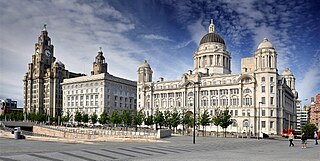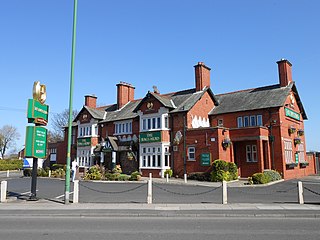
Merseyside is a ceremonial and metropolitan county in North West England. It borders Lancashire to the north, Greater Manchester to the east, Cheshire to the south, the Welsh county of Flintshire across the Dee Estuary to the southwest, and the Irish Sea to the west. The largest settlement is the city of Liverpool.

The Metropolitan Borough of Sefton is a metropolitan borough of Merseyside, England. It was formed on 1 April 1974 under the Local Government Act 1972, by the amalgamation of the county boroughs of Bootle and Southport, the municipal borough of Crosby, the urban districts of Formby and Litherland, and part of West Lancashire Rural District. It consists of a coastal strip of land on the Irish Sea which extends from Southport in the north to Bootle in the south, and an inland part to Maghull in the south-east, bounded by the city of Liverpool to the south, the Metropolitan Borough of Knowsley to the south-east, and West Lancashire to the east.

Little Crosby is a small village in the Sefton district of Merseyside, England. Despite being within 8 miles of Liverpool it has retained its rural character by, for example, opting not to have street lights. Until 1974 it was in Lancashire.

The Lady Lever Art Gallery is a museum founded and built by the industrialist and philanthropist William Lever, 1st Viscount Leverhulme and opened in 1922. The Lady Lever Art Gallery is set in the garden village of Port Sunlight, on the Wirral and one of the National Museums Liverpool.

Lydiate is a village and civil parish in the Metropolitan Borough of Sefton on Merseyside, England but historically in Lancashire. It is located 1.5 miles (2 km) north of Maghull, with which it has a common history. At the 2001 Census the civil parish of Lydiate had a population of 6,672, reducing to 6,308 at the 2011 Census.

Sefton is a village and civil parish in the Metropolitan Borough of Sefton in Merseyside, England. Located to the south west of Maghull and to the north east of Great Crosby, it is on the flood plain of the River Alt. The village is bisected by the B5422, Brickwall Lane, which cuts also through the site of the moat of Sefton Old Hall, a recognised National Monument. At the 2001 Census the population was recorded as 772, increasing to 855 at the 2011 Census.

Lunt is a small village in the civil parish of Sefton, in the borough of Sefton in Merseyside, England, close to Sefton Village and to the west of Maghull and is in the L29 postcode.

Little Altcar is a village and civil parish in the Metropolitan Borough of Sefton on Merseyside, within the boundaries of the historic county of Lancashire and on the West Lancashire Coastal Plain of England. The village forms part of the built-up area of Formby. It had a population of 892 in the 2001 Census, increasing to 910 at the 2011 Census.

Hightown is a village and civil parish in the Metropolitan Borough of Sefton in Merseyside, England, located midway between the city of Liverpool and the coastal resort of Southport. It is 8 miles north of Liverpool city centre and is located on the coast near the boundary of the Mersey Estuary and Liverpool Bay. The River Alt joins the sea at this point and forms an estuary. There is a pumping station on the River Alt at Altmouth, built 1972, as part of a programme to alleviate flooding in the area. This is on the Altcar Rifle Range, a Territorial Army base originally established in 1860 by Lt. Col. Gladstone.

Thornton is a village in the Metropolitan Borough of Sefton, in Merseyside, England. Within the boundaries of the historic county of Lancashire and situated to the north east of Crosby, it is a residential area of semi-detached and detached housing which dates mainly from the 1930s. Many of the houses, particularly those around Edge Lane and Water Street, feature notably long gardens. The A565 Liverpool-Southport road serves the area. At the 2001 Census the population of the village and civil parish was recorded as 2,262, falling to 2,139 at the Census 2011.

Crosby was a constituency in Merseyside, represented in the House of Commons of the Parliament of the United Kingdom from 1950 until 2010. It elected one Member of Parliament (MP) by the first past the post system of election.

Knowsley North and Sefton East was a county constituency represented in the House of Commons of the Parliament of the United Kingdom. It elected one Member of Parliament (MP) by the first past the post system of election.

Sefton Central is a constituency represented by Bill Esterson of the Labour Party since 2010.

Ormskirk was a county constituency represented in the House of Commons of the Parliament of the United Kingdom. It elected one Member of Parliament (MP) by the first past the post system of election. It was created by the Redistribution of Seats Act 1885 as a division of the parliamentary county of Lancashire. The constituency boundaries were changed in 1918, 1950, 1955 and 1974.

The John Moores Painting Prize is a biennial award to the best contemporary painting, submission is open to the public. The prize is named for Sir John Moores, noted philanthropist, who established the award in 1957. The winning work and short-listed pieces are exhibited at the Walker Art Gallery as part of the Liverpool Biennial festival of visual art.
The Weld family are a cadet branch, arisen in 1843, of the English Welds of Lulworth. It is an old gentry family which claims descent from Eadric the Wild and is related to other Weld branches in several parts of the United Kingdom, notably from Willey, Shropshire and others in the Antipodes and America. A notable early Weld was William de Welde, High Sheriff of London in 1352, whose progeny moved in and out of obscurity.
Henry Blundell was an English art collector, who amassed a large collection of art and antiquities at Ince Blundell Hall in Lancashire.

Brighton-le-Sands is an area of Merseyside, England, in the borough of Sefton. It is located close to Crosby, situated between Blundellsands to the north, Waterloo to the south and Great Crosby to the east.

Ince Blundell Hall is a former country house near the village of Ince Blundell, in the Metropolitan Borough of Sefton, Merseyside, England. It was built between 1720 and 1750 for Robert Blundell, the lord of the manor, and was designed by Henry Sephton, a local mason-architect. Robert's son, Henry, was a collector of paintings and antiquities, and he built impressive structures in the grounds of the hall in which to house them. In the 19th century the estate passed to the Weld family. Thomas Weld Blundell modernised and expanded the house, and built an adjoining chapel. In the 1960s the house and estate were sold again, and have since been run as a nursing home by the Canonesses of St. Augustine of the Mercy of Jesus.
The Church of the Holy Family is attached to the service wing of Ince Blundell Hall, near the village of Ince Blundell, Sefton, Merseyside, England. It is both an estate church and an active Roman Catholic parish church in the Archdiocese of Liverpool. The church was built in 1858–60, it was designed by J. J. Scoles, and it contains paintings by Gebhard Flatz. It is recorded in the National Heritage List for England as a designated Grade II* listed building.



















